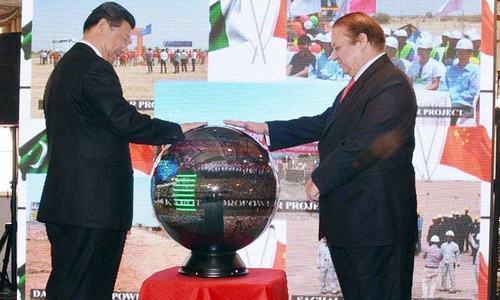- And then the problems began. Their first application for a generation licence was rejected by Nepra.

ONE of the more exciting of the CPEC power projects to be undertaken on priority in Pakistan was the giant solar park to be built in Bahawalpur. It was part of the Quaid-i-Azam Solar Park and was part of what they call the ‘early harvest’ projects, meaning the first to come online.
The first MoU for the project was signed in August 2013 between the governments of China and Punjab. The provincial government owned the project, and in the first solar power plant that was inaugurated under it, the provincial government was also a joint venture partner with a Chinese contractor.
Later in July 2014, another MoU was signed between the government of Punjab and private Chinese developer that expressed an interest in setting up a 900MW solar plant in the same park. This MoU was signed in the presence of the prime minister in Beijing.
And then the problems began. Their first application for a generation licence was rejected by Nepra.
Things moved fast initially, due to interest in the project at the top. The Project Commitment Agreement was signed a week later, again witnessed by the prime minister and both sides agreed to a tariff of Rs14 per unit outside of taxes, along with the timeline. In August it was placed on the early harvest list and prequalification documents were submitted, and a letter of interest from the Punjab Power Development Board was issued in September.
On Jan 22, 2015, the power regulator and tariff setting body Nepra announced a revised upfront tariff for solar projects at Rs14 per unit for the first 10 years of operation, and this tariff was notified in the official gazette on July 1, 2015, with the stipulation that this offer would be valid for a period of six months, until December 2015. The project sponsors applied for a generation licence under this tariff regime.
Meanwhile, land allotment had already been done in April, for the first batch of 300MW worth of solar power, and in May, the second batch of 600MW also received its allotment. In May the feasibility studies were done for the first batch, and June saw the feasibility for the second batch of 600MW approved.
Grid interconnection studies for both projects were completed by the sponsors in July, and submitted for approval to the National Transmission and Dispatch Company (NTDC), which is a requirement for all private power projects. On July 4, the prime minister met the project sponsors and asked them to move the timelines of the project further up, to April 2016. Right around that time, the company applied for a generation licence from Nepra, so it could begin with lining up the financing and placing the orders for the equipment
And then the problems began. Their first application for a generation licence was rejected by Nepra on July 14, 2015, on the grounds that a duly approved grid interconnection study has not been included. The sponsors pressed NTDC to expedite its approval of the study, and on July 24 received a reply that their study has been ‘vetted’, that concerns of NTDC have been addressed, but the report should be sent to the Central Power Purchasing Agency and the Multan Electric Power Company (Mepco), whose transmission facilities would be used to evacuate the power.
The approval from NTDC was received on Aug 17, and three days later, the company again sent an application for acceptance of the tariff and grant of permission to proceed with project execution.
Then things started to go from bad to worse. To cut a long and detailed story short, when Nepra received the NTDC grid interconnection approval, it objected that this had been issued without a final report of the consultant on renewable energy in the national grid. Therefore, Nepra said in a letter dated Oct 5, 2015, the NTDC certification of the grid interconnection study is “not adequate and useful for the Authority” and asked for the grounds on which these certificates had been given in the absence of an overarching study on the induction of renewable energy. In all previous communications with the project sponsors, Nepra had made no mention of this.
I will surmise that this letter fell like a bombshell on the sponsors. A few more letters were exchanged, where NTDC explained that issuing a certification on grid interconnection for a specific project was a different matter from an overarching study on the role of renewables in the total energy mix of the country. But on Oct 28, Nepra demanded “complete detail of all the solar projects awaiting approval” before proceeding. On Nov 4, NTDC wrote back that the details demanded were being prepared, and that “approval as well as certificates for power evacuation in respect of above mentioned three solar projects already given be considered withdrawn”.
In December, the tariff expired, and Nepra determined a new, lower tariff for solar energy. The project sponsors went into litigation, and won an order from the Lahore High Court that Nepra should hold another round of tariff hearings for this particular project, which was approved to enter under the old tariff regime, and that the grounds on which its application was rejected were baseless. The sponsors are now waiting for a date when Nepra will hold the next hearing, and matter will begin all over again.
This is the tale of one CPEC project. It’s easy to assign blame when reading the simple facts of the story, but it must be remembered that the original upfront solar tariff that Nepra had granted was one of the highest in the world, and was based entirely on cost structures provided by one party — the QAS (Pvt) Ltd, which is a joint venture between the government of Punjab and a Chinese group.
That party is now enjoying the benefits of an extraordinary Rs17 per unit tariff, where the competitive price of solar in the world today is closer to Rs4. Meanwhile, all the other parties that were in the queue for that tariff are today licking their wounds.
The writer is a member of staff.
Twitter: @khurramhusain
Published in Dawn, October 20th, 2016

















































